Prague
Czech Republic
Introduction
Czech Praha
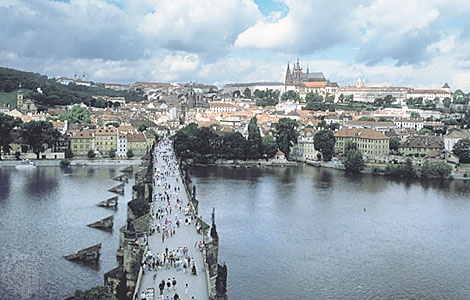 city, capital of the Czech Republic. Lying at the heart of Europe, it is one of the continent's finest cities and the major Czech economic and cultural centre. The city has a rich architectural heritage that reflects both the uncertain currents of history in Bohemia and an urban life extending back more than 1,000 years.
city, capital of the Czech Republic. Lying at the heart of Europe, it is one of the continent's finest cities and the major Czech economic and cultural centre. The city has a rich architectural heritage that reflects both the uncertain currents of history in Bohemia and an urban life extending back more than 1,000 years.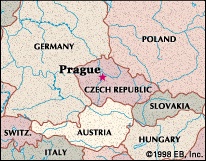
The physical attractions and landmarks of Prague (World Heritage site) are many. Among the finest is the Charles Bridge (Karlův most), which stands astride the Vltava River. The winding course of the Vltava (Vltava River), with its succession of bridges and changing vistas, contrasts with the ever-present backdrop of the great castle of Hradčany (Prague Castle), which dominates the left-bank region of the city from behind massive walls set high on a hill. The narrow streets and little taverns and restaurants of the older quarters contrast with the broad sweep of Wenceslas Square and modern parks and housing developments, while the great 18th-century Baroque palaces have their own elegance and splendour. Seen from the surrounding hills, the many church towers make up a unique perspective, giving Prague its description as the “city of a hundred spires.” This architectural harmony was enhanced by post-1945 planning, which preserved the ancient core of the city as a major monument and carefully supervised all modern building. In 1992 the historic city centre was added to UNESCO's World Heritage List (World Heritage site).
Prague is famous for its cultural life. Wolfgang Amadeus Mozart lived there, and his Prague Symphony and Don Giovanni were first performed in the city. In addition, the lyric music of the great Czech composers Bedřich Smetana, Antonín Dvořák, and Leoš Janáček is commemorated each year in a spring music festival. The U kalicha (“At the Chalice”) beer parlour, which is still popular with local residents and tourists alike, provided the setting for the humorously antiauthoritarian activities of Schweik, immortalized by the novelist Jaroslav Hašek in The Good Soldier Schweik. The writings of Franz Kafka (Kafka, Franz), dwelling in a different way on the dilemmas and predicaments of modern life, also seem indissolubly linked with life in this city. Pop. (2005 est.) 1,170,571.
Physical and human geography
The landscape
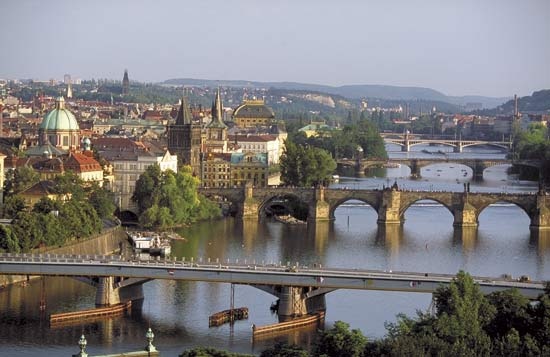 From its original small riverside settlements, Prague has spread over its hills, up river valleys, and along riverside terraces. The Prague metropolitan area covers 192 square miles (496 square kilometres).
From its original small riverside settlements, Prague has spread over its hills, up river valleys, and along riverside terraces. The Prague metropolitan area covers 192 square miles (496 square kilometres).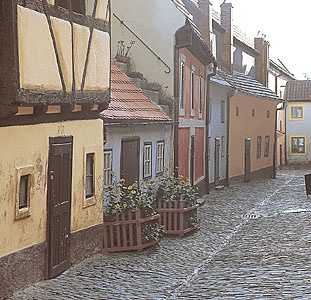 The city's core, with its historic buildings, bridges, and museums, is a major centre of employment and traffic congestion. Around the core is a mixed zone of industrial and residential areas, containing about half the city's population and nearly half its jobs. Surrounding this area is the outer city development zone, and beyond this is yet another zone of development containing new industrial areas, parks and recreation areas, and sports facilities. Finally, there is a belt of agricultural land and open countryside, where farms and market gardening projects satisfy Prague's demand for food.
The city's core, with its historic buildings, bridges, and museums, is a major centre of employment and traffic congestion. Around the core is a mixed zone of industrial and residential areas, containing about half the city's population and nearly half its jobs. Surrounding this area is the outer city development zone, and beyond this is yet another zone of development containing new industrial areas, parks and recreation areas, and sports facilities. Finally, there is a belt of agricultural land and open countryside, where farms and market gardening projects satisfy Prague's demand for food.The lowest point in the city is 623 feet (190 metres) above sea level, and the highest point is 1,247 feet (380 metres) on White Mountain (Bílá hora). The climate of Prague is typically mid-continental, with temperatures there averaging 67° F (19.3° C) in July and 31° F (−0.6° C) in January.
The people
Prague has a homogeneous population. There is a small Slovak community, but the overwhelming majority of residents are Czechs. The city has a number of demographic peculiarities stemming mainly from the effects of World War II; there are more women than men, and a sizable proportion of the female population is past the age of fertility. The natural rate of population increase is very small. A tendency toward small families is a reflection of both difficulties in housing and increased participation by both parents in the workforce. Migration into the city has continued.
The economy
Industry and employment
Though Prague is renowned for its cultural life and monuments, it has also played an important role in the economic life of what is now the Czech Republic since the early and intensive development in the 19th century of such industries as those producing textiles and machinery. Industry is the largest employer, followed by commerce, construction, education, culture, administration, and transport and communications. Nearly half the labour force is female; the proportion of women is almost one-half in manufacturing, but it is considerably higher in education and culture, in trade, and in the health field.
In manufacturing, the production of machinery occupies the majority of workers, followed, in about equal numbers, by the production of food, electronics, and chemicals. A large portion of the city's manufactured products are consumer goods.
As part of a decentralization plan for the city's growth, since the 1950s industrial districts and warehouses have been located or relocated on the outskirts of Prague. The aim is to provide increased job opportunities in the vicinity of new residential areas, thereby reducing the pressure on the city's central core.
Transportation
Much of the inner-city transportation is handled by bus, tram, and subway (metro) systems, which are inexpensive and subsidized. Despite the efforts to meet the demands of the growing population with an adequate public transportation system, the number of passenger cars and commercial vehicles has increased, resulting in plans for a major urban motorway system to include 10 radial arteries connecting Prague with the national road network.
Prague is one of the nation's major railway junctions, with three main stations and three freight transport circuits. The international airport at nearby Ruzyně was expanded and modernized in the 1960s to serve as a hub at the centre of Europe. A new port has been built at the confluence of the Vltava and Berounka rivers. The passenger boats that ply the Vltava during the summer are a popular tourist attraction.
Administration and social conditions
Government
Prague is the seat of government of the entire Czech Republic. The city is also the administrative centre for the Central Bohemian Region, of which the conurbation occupies about one-third. The Prague Municipal National Committee and the Central Bohemian Regional National Committee coordinate town planning, environmental control, and other projects. Prague is divided into districts, each with its own district national committee, while the settlements included in Prague since the late 1940s have retained their own committees.
Public services
The standard municipal services—the supply of natural gas, electricity, and water and the treatment and disposal of sewage and refuse—were consolidated under state control after World War II and have been considerably modernized and expanded as part of overall urban planning. The high percentage of employed women has caused municipal authorities to turn attention toward the provision of nurseries for the children of working mothers. Other facilities include swimming pools, often run in conjunction with sports organizations. On the river the city provides mooring positions for pleasure boats.
Like cities in other eastern European countries, Prague has difficulties with the supply and maintenance of housing. Much of the housing in the inner city consists of small apartments in need of renovation and modernization, while the rate of construction of apartments in the newer zones lags behind the need. Privately owned houses constitute less than 15 percent of all Prague's housing units. In response to the problem, new housing developments have been built in the peripheral areas. Referred to as “towns,” they include North Town (Severní město), South Town (Jižní město), and Southwest Town (Jihozápadní město).
During the Communist era, all retail establishments—food and department stores and self-service establishments—were publicly owned and were part of the municipal system. There are numerous small restaurants and taverns, many of which—especially in the Malá Strana (Lesser Quarter)—have an intimate and historic atmosphere and offer fine views of the city and the river.
Education
There are several institutions of higher education in Prague, but by far the most famous is Charles University, founded in 1348 and the oldest in central Europe. The Academy of Arts and the Academy of Music (with a conservatory founded in 1811) are also important. The activity of the Czech Academy of Sciences (founded in 1952 as the Czechoslovak Academy of Sciences) is supplemented by many specialized institutions; the academy sponsors a number of international congresses. Higher education in the city benefits from a tradition that can count among its scholars and teachers the great 17th-century astronomers Tycho Brahe and Johannes Kepler and the noted modern physicist Albert Einstein, who taught in Prague in 1911–12.
Health
As the capital city, Prague contains some of the country's main health facilities. These include hospitals, specialized medical clinics, and outpatient clinics. The most noted facilities are those that specialize in plastic surgery, orthopedics, and urology.
Cultural life
Prague has a renowned and active musical life, which reaches a high point each year in the internationally known spring music festival. The city's fine orchestras—the Prague Symphony and the Czech Philharmonic—have won reputations abroad. Theatrical traditions are also strong, with more than 20 well-attended theatres in the city. There are also many museums and galleries, and a Palace of Culture was completed in 1981.
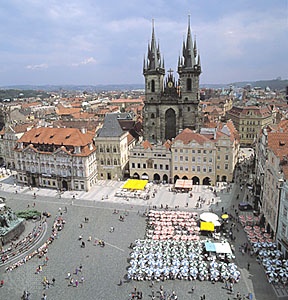 Perhaps the greatest treasures of the city, however, are the 2,000 officially recognized architectural and artistic monuments, ranging in period from the Romanesque through the Gothic to the Baroque, Rococo, Classical, and Neoclassical. The interiors of the buildings, which often house major art collections, have been restored since 1945. The most notable Romanesque monument is probably the 10th-century Church of St. George, behind the north wall of Hradčany. To the west is its more massive successor, the basically Gothic St. Vitus' Cathedral, the twin spires of which dominate the city skyline. Other Gothic monuments include the Týn Church on Staroměstské (“Old Town”) Square; the elegant Powder Tower, marking the former city walls in what is now the busy Příkopy shopping area; the restored Bethlehem Chapel, where Jan Hus preached in the 15th century; and the St. Agnes Convent, built in 1234 and notable for its collection of 14th-century paintings. The Old-New Synagogue and the tumbling, crowded gravestones of the Old Jewish Cemetery—Europe's oldest—betoken the strong Jewish tradition in Prague life.
Perhaps the greatest treasures of the city, however, are the 2,000 officially recognized architectural and artistic monuments, ranging in period from the Romanesque through the Gothic to the Baroque, Rococo, Classical, and Neoclassical. The interiors of the buildings, which often house major art collections, have been restored since 1945. The most notable Romanesque monument is probably the 10th-century Church of St. George, behind the north wall of Hradčany. To the west is its more massive successor, the basically Gothic St. Vitus' Cathedral, the twin spires of which dominate the city skyline. Other Gothic monuments include the Týn Church on Staroměstské (“Old Town”) Square; the elegant Powder Tower, marking the former city walls in what is now the busy Příkopy shopping area; the restored Bethlehem Chapel, where Jan Hus preached in the 15th century; and the St. Agnes Convent, built in 1234 and notable for its collection of 14th-century paintings. The Old-New Synagogue and the tumbling, crowded gravestones of the Old Jewish Cemetery—Europe's oldest—betoken the strong Jewish tradition in Prague life. Baroque buildings are the city's greatest single artistic treasure, among them the splendid Valdštejn and Clam-Gallas palaces, St. Nicholas Church, and the Antonín Dvořák Museum. The geometric tiling of the Golz-Kinský Palace facade provides a distinctive glimpse of the Rococo style. Classical buildings include the Bedřich Smetana Museum on the riverside and the elegant Belvedere Palace (the former Royal Summer Palace). The National Museum and the National Theatre are the main Neoclassical buildings.
Baroque buildings are the city's greatest single artistic treasure, among them the splendid Valdštejn and Clam-Gallas palaces, St. Nicholas Church, and the Antonín Dvořák Museum. The geometric tiling of the Golz-Kinský Palace facade provides a distinctive glimpse of the Rococo style. Classical buildings include the Bedřich Smetana Museum on the riverside and the elegant Belvedere Palace (the former Royal Summer Palace). The National Museum and the National Theatre are the main Neoclassical buildings.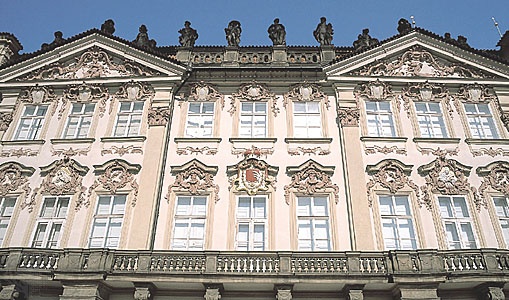 The beauty of the city is enhanced by its many parks and gardens, including a major cultural, entertainment, and sports centre in the park named for Julius Fučík (a resistance leader of World War II) and a large zoo in suburban Troja. Recreational facilities also include the vast Strahov sports complex—containing three stadiums, the largest of which, Spartakiáda Stadium, holds 250,000 spectators and is used for the mass gymnastic display known as the Spartakiáda—as well as numerous other sports and cultural centres, with emphasis on facilities for youth. The film studios at Barrandov, on the city outskirts, have produced a number of high-quality motion pictures, and there is a museum of modern sculpture at Zbraslav.
The beauty of the city is enhanced by its many parks and gardens, including a major cultural, entertainment, and sports centre in the park named for Julius Fučík (a resistance leader of World War II) and a large zoo in suburban Troja. Recreational facilities also include the vast Strahov sports complex—containing three stadiums, the largest of which, Spartakiáda Stadium, holds 250,000 spectators and is used for the mass gymnastic display known as the Spartakiáda—as well as numerous other sports and cultural centres, with emphasis on facilities for youth. The film studios at Barrandov, on the city outskirts, have produced a number of high-quality motion pictures, and there is a museum of modern sculpture at Zbraslav.History
The early period
The foundation of the city
For thousands of years that portion of the Vltava's course where Prague was to rise was crossed by trade routes linking northern and southern Europe. The region is replete with Paleolithic relics, and Neolithic farmers inhabited the region from around 5000 to 2700 BC. Celts had settlements in the region from about 500 to 200 BC, including the fortified Závist, to the south of Prague. From the 4th to the 6th century AD, Slavs appeared on the Vltava banks, followed by the Avars.
The first settlement at what is now Prague has been traced to the second half of the 9th century. The oldest building was Vyšehrad (hrad, “castle”), set on a commanding right-bank hill. It was followed by what was to become Hradčany, set on an equally commanding left-bank site a little downstream. Legend (stirringly told in Smetana's opera (Smetana, Bedřich) Libuše) ascribes the foundation of Prague to a Princess Libuše and her husband, Přemysl, founder of the Přemyslid dynasty (Přemysl, house of); legend notwithstanding, the Přemyslids, in power from about 800 to 1306, consolidated a political base centred on Prague that was to be the nucleus of the Bohemian state and that enabled the natural trade advantages of the city site to develop under defensive protection. The dynasty included St. Wenceslas (Wenceslas I) (Václav), who was murdered by his brother Boleslav in about 939 and whose statue now looks down upon the square to which his name has been given; and Boleslav I, whose reign (c. 936–967) witnessed the consolidation of power against a German threat. The little community flourished, and in 965 the Jewish merchant and traveler Ibrāhīm ibn Yaʿqūb was able to describe it as a “busy trading centre.” In 973 the bishopric of Prague was founded.
Medieval growth
The economic expansion of the community was reflected in the topography of the city. A market centre on the right bank, opposite Hradčany, developed into the Old Town (Staré město), particularly after the construction of the first stone bridge, the Judith Bridge, over the river in 1170. By 1230 the Old Town had been given borough status and was defended by a system of walls and fortifications. On the opposite bank, under the walls of Hradčany, the community known as Malá Strana (literally, “Small Side”) was founded in 1257. Following the eclipse of the Přemyslids, the house of Luxembourg came to power when John of Luxembourg, son of the future emperor Henry VII, became king of Bohemia. His son, Charles IV, Bohemian king and Holy Roman emperor, had his capital at Prague from 1346 to 1378 and took considerable personal interest in the development of the city. In 1348 he founded Charles University, the first in central Europe, which was later to attract scholars and students from throughout the Continent. His reign also saw the growth of the planned New Town (Nové město) adjacent to the Old Town; construction of the Charles Bridge (1357, reconstructed in 1970) linking the Old Town and the Malá Strana; and the beginning (1344) of the great St. Vitus' Cathedral, which was not completed until 1929. Other buildings included the Carolinum (the central hall of the university), the town hall (destroyed in 1945), and several churches and monasteries in the New Town. The Jewish ghetto was also developed, and the bishopric was raised to an archbishopric in 1344.
By the 14th century Prague had become a major central European city, with the Czech money minted at nearby Kutná Hora serving as the hard currency of the entire region. Foreign merchants, notably Germans and Italians, became economically and politically powerful in uneasy alliance with the kings. The social order, however, became less stable because of the emergent guilds of craftsmen, themselves often torn by internal conflicts. The town paupers added a further volatile element.
The Reformation and the Thirty Years' War
Prague played a significant role in the Reformation. The sermons of Jan Hus (Hus, Jan), a scholar at the university, begun in 1402 at the now-restored Bethlehem Chapel and carrying forward the criticisms of the church developed by the English reformer John Wycliffe, endeared him to the common people but brought him into conflict with Rome; he was burned at the stake in the town of Constance (Konstanz, Ger.) in 1415. Popular uprisings in 1419, led by the Prague priest Jan Želivský, included the throwing of city councillors from the windows of the New Town Hall in the incident known as the first Defenestration of Prague. The next year Hussite peasant rebels, led by the great military leader Jan Žižka (Žižka, Jan, Count (Hrabě)), joined forces with the Hussites of Prague to win a decisive victory over the Roman Catholic king (later emperor) Sigismund at nearby Vítkov Hill.
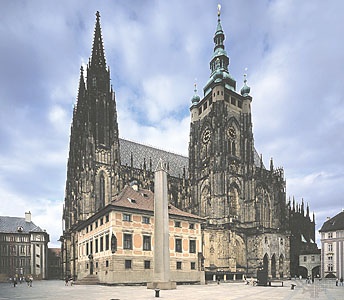 During the next 200 years, the wealthy merchants became ascendant once more, and the late Gothic architectural style flourished in many churches and buildings, reaching a peak in the fine Vladislav Hall of Hradčany. In 1526, however, the Roman Catholic Habsburgs became rulers of Bohemia and attempted to crush Czech Protestantism. The second Defenestration of Prague (1618), when the governors of Bohemia were thrown from the windows of the council room in Hradčany—one of the major events precipitating the Thirty Years' War—was followed by the decisive defeat of Protestant forces at the Battle of the White Mountain (White Mountain, Battle of), near the city, in 1620. Twenty-seven Prague commoners and Czech noblemen were executed on the Staroměstské Square in 1621; the city ceased to be the capital of the empire, was occupied by Saxons (1631) and Swedes (1648), and went into a decline hastened by two outbreaks of plague.
During the next 200 years, the wealthy merchants became ascendant once more, and the late Gothic architectural style flourished in many churches and buildings, reaching a peak in the fine Vladislav Hall of Hradčany. In 1526, however, the Roman Catholic Habsburgs became rulers of Bohemia and attempted to crush Czech Protestantism. The second Defenestration of Prague (1618), when the governors of Bohemia were thrown from the windows of the council room in Hradčany—one of the major events precipitating the Thirty Years' War—was followed by the decisive defeat of Protestant forces at the Battle of the White Mountain (White Mountain, Battle of), near the city, in 1620. Twenty-seven Prague commoners and Czech noblemen were executed on the Staroměstské Square in 1621; the city ceased to be the capital of the empire, was occupied by Saxons (1631) and Swedes (1648), and went into a decline hastened by two outbreaks of plague.Evolution of the modern city
The return of more settled conditions in central Europe was marked by renewed economic growth, and Prague's population grew from 40,000 in 1705 to more than 80,000 by 1771. In 1784 the Old Town, the New Town, the Malá Strana, and the Hradčany complex were administratively united into one city. The merchants and the mostly German, Spanish, and Italian nobility who were active in and around Prague in this period had an enormous effect on both architecture and cultural life. Outstanding architects created magnificent palaces and gardens, and churches in the Prague version of the Baroque style sprang up throughout the city.
The onset of the Industrial Revolution had major effects in Prague. The first suburb (Karlín) was established in 1817, and in the next 20 years many factories sprang up, often in association with the coal mines and ironworks at Kladno and Králův Dvůr, not far away. The population exceeded 100,000 by 1837, and expansion continued after the city received its first railway eight years later. The rise of a working class and of strong nationalistic sentiments had a profound effect on the city; students, artisans, and workers took to the barricades against the ruling Austrians when revolution flared briefly in 1848. Within 20 years Czechs had won a majority on the City Council, and Czech cultural life was experiencing a renascence centred on Prague. The Neoclassical building of the National Museum and the National Theatre are only two examples of the building that took place in this period. By the 1890s the first electric streetcars (trams) were running in the city, urban services were being reorganized, and a replica of the Eiffel Tower overlooked the city from Petřín Hill.
In 1918 Prague became the capital of the newly independent Czechoslovak republic. By 1930 the population had reached 850,000. The city suffered a setback following the surrender of large parts of Bohemia and Moravia to Germany under the Munich Agreement of 1938. The citizens rose in revolt on May 5, 1945, and held the city until the Red Army arrived four days later. After World War II economic reconstruction began, careful planning was necessary to restore and preserve the historic monuments of the city centre. From the 1970s there was an increasing emphasis on the development of new satellite communities. The city continued to grow, although most of its population growth was attributable to annexation. The so-called Prague Spring of 1968 (Prague Spring), a short-lived excursion into liberalized social and governmental controls attempted by the government of Alexander Dubček, was terminated by Soviet military action in August of that year.
In November 1989, Prague's Wenceslas Square became the cradle of the movement that swiftly ended four decades of communist rule in Czechoslovakia. An officially sanctioned march in the city, commemorating the death of a student at the hands of Nazis in 1939, resulted in police violence and public disorder. Indignation at the current regime kindled further unrest, and in the second half of November students, young intellectuals, and later older people, totaling some half a million, demonstrated in the streets of the capital. Subsequent pressure led to the resignation of the entire Communist Party leadership and the formation of a coalition government headed by noncommunists. When Czechoslovakia itself was dissolved into its constituent republics on January 1, 1993, Prague maintained its prominent international status as capital of the Czech Republic.
Throughout the 1990s Prague underwent a cultural, economic, and political transformation. The stock market opened for the first time since World War II, the city was modernized, and it became a major tourist destination. Capping Prague's rebirth, it was designated a European City of Culture in 2000.
Additional Reading
Geoffrey Moorhouse, Prague (1980), offers information on all aspects of the city. Guidebooks with information on history include Alois Svoboda, Prague (1965, reissued 1968), in English; Emanuel Poche, The Golden Lane on Prague Castle (1969; originally published in Czech, 1969), a description of the picturesque street of Hradčany; and František Kafka, Baedeker's Prague, trans. from German (1987). Photographic views of the city are presented in Jiří Doležal and Evžen Veselý, Památky staré Prahy (1966), a survey of historical Prague, with brief commentary; Eugen Vasiliak, Nad Prahou: Prague Seen from Above (1966), a book of aerial photographs of old and new Prague with text in six languages; Miroslav Korecký, Prague in Colour (1976; originally published in Czech, 1975), which portrays the city's many architectural styles and major landmarks; Radomira Sedlakova, Prague: An Architectural Guide, trans. from Czech (1997); and Bohumil Landisch and Vít Paloch, Praha: Praga: Prague (1982), with annotations in Czech, English, German, and Russian. A study of the city from the perspective of urban sociology is provided by F.W. Carter, “Prague and Sofia: An Analysis of Their Changing Internal City Structure,” ch. l5 in R.A. French and F.E. Ian Hamilton (eds.), The Socialist City: Spatial Structure and Urban Policy (1979), pp. 425–459. See also Jiří Hrůza and Blahomír Borovička, Prague: A Socialist City (1985). F.W. Carter, “Kafka's Prague,” ch. 2 in J.P. Stern (ed.), The World of Franz Kafka (1980), pp. 30–43, is an essay on Prague in Kafka's lifetime. Works describing the history of the city include Count (Franz) Lützow, The Story of Prague (1902, reprinted 1971); Josef Janáček (ed.), Dějiny Prahy (1964), covering the development and history of the city from the earliest times to 1960; Joseph Wechsberg, Prague: The Mystical City (1971), essays on Prague's history; and Josef Janáček, Malé dějiny Prahy, 3rd rev. ed. (1983), on history and architecture.
- Richard Hurrell Froude
- Richard I
- Richard II
- Richard III
- Richard James Mulcahy
- Richard James Oglesby
- Richard J Daley
- Richard Jefferies
- Richard Joel Russell
- Richard John Seddon
- Richard Jones
- Richard Jordan Gatling
- Richard Joseph Neutra
- Richard J. Roberts
- Richard Keigwin
- Richard Kirwan
- Richard Knolles
- Richard Kostelanetz
- Richard Krafft-Ebing, Freiherr von
- Richard Kuhn
- Richard Leakey
- Richard Le Grant
- Richard Lemon Lander
- Richard Lepsius
- Richard Lester